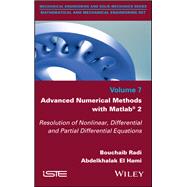The purpose of this book is to introduce and study numerical methods basic and advanced ones for scientific computing. This last refers to the implementation of appropriate approaches to the treatment of a scientific problem arising from physics (meteorology, pollution, etc.) or of engineering (mechanics of structures, mechanics of fluids, treatment signal, etc.). Each chapter of this book recalls the essence of the different methods resolution and presents several applications in the field of engineering as well as programs developed under Matlab software.








